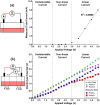Changes in the extracellular microenvironment and osteogenic responses of mesenchymal stem/stromal cells induced by in vitro direct electrical stimulation
- PMID: 33643602
- PMCID: PMC7894594
- DOI: 10.1177/2041731420974147
Changes in the extracellular microenvironment and osteogenic responses of mesenchymal stem/stromal cells induced by in vitro direct electrical stimulation
Abstract
Electrical stimulation (ES) has potential to be an effective tool for bone injury treatment in clinics. However, the therapeutic mechanism associated with ES is still being discussed. This study aims to investigate the initial mechanism of action by characterising the physical and chemical changes in the extracellular environment during ES and correlate them with the responses of mesenchymal stem/stromal cells (MSCs). Computational modelling was used to estimate the electrical potentials relative to the cathode and the current density across the cell monolayer. We showed expression of phosphorylated ERK1/2, c-FOS, c-JUN, and SPP1 mRNAs, as well as the increased metabolic activities of MSCs at different time points. Moreover, the average of 2.5 μM of H2O2 and 34 μg/L of dissolved Pt were measured from the electrically stimulated media (ES media), which also corresponded with the increases in SPP1 mRNA expression and cell metabolic activities. The addition of sodium pyruvate to the ES media as an antioxidant did not alter the SPP1 mRNA expression, but eliminated an increase in cell metabolic activities induced by ES media treatment. These findings suggest that H2O2 was influencing cell metabolic activity, whereas SPP1 mRNA expression was regulated by other faradic by-products. This study reveals how different electrical stimulation regime alters cellular regenerative responses and the roles of faradic by-products, that might be used as a physical tool to guide and control cell behaviour.
Keywords: Electrical stimulation; bone regeneration; computational modelling; faradic by-products; mesenchymal stem/stromal cells.
© The Author(s) 2021.
Conflict of interest statement
Declaration of conflicting interests: The author(s) declared no potential conflicts of interest with respect to the research, authorship, and/or publication of this article.
Figures







Similar articles
-
Direct electrical stimulation enhances osteogenesis by inducing Bmp2 and Spp1 expressions from macrophages and preosteoblasts.Biotechnol Bioeng. 2019 Dec;116(12):3421-3432. doi: 10.1002/bit.27142. Epub 2019 Sep 23. Biotechnol Bioeng. 2019. PMID: 31429922 Free PMC article.
-
In vitro effect of direct current electrical stimulation on rat mesenchymal stem cells.PeerJ. 2017 Jan 12;5:e2821. doi: 10.7717/peerj.2821. eCollection 2017. PeerJ. 2017. PMID: 28097053 Free PMC article.
-
Electrical stimulation of adipose-derived mesenchymal stem cells and endothelial cells co-cultured in a conductive scaffold for potential orthopaedic applications.J Tissue Eng Regen Med. 2018 Apr;12(4):878-889. doi: 10.1002/term.2441. Epub 2017 Jun 27. J Tissue Eng Regen Med. 2018. PMID: 28482125
-
Impact of developmental origin, niche mechanics and oxygen availability on osteogenic differentiation capacity of mesenchymal stem/stromal cells.Acta Biochim Pol. 2019 Dec 29;66(4):491-498. doi: 10.18388/abp.2019_2893. Acta Biochim Pol. 2019. PMID: 31883439 Review.
-
Mesenchymal Stromal Cell Secretome: Influencing Therapeutic Potential by Cellular Pre-conditioning.Front Immunol. 2018 Dec 4;9:2837. doi: 10.3389/fimmu.2018.02837. eCollection 2018. Front Immunol. 2018. PMID: 30564236 Free PMC article. Review.
Cited by
-
Enhanced cytotoxic activity of natural killer cells from increased calcium influx induced by electrical stimulation.PLoS One. 2024 Apr 18;19(4):e0302406. doi: 10.1371/journal.pone.0302406. eCollection 2024. PLoS One. 2024. PMID: 38635551 Free PMC article.
-
Anodic TiO2 Nanotubes: Tailoring Osteoinduction via Drug Delivery.Nanomaterials (Basel). 2021 Sep 11;11(9):2359. doi: 10.3390/nano11092359. Nanomaterials (Basel). 2021. PMID: 34578675 Free PMC article. Review.
-
Electroactive Biomaterials for Facilitating Bone Defect Repair under Pathological Conditions.Adv Sci (Weinh). 2023 Jan;10(2):e2204502. doi: 10.1002/advs.202204502. Epub 2022 Dec 1. Adv Sci (Weinh). 2023. PMID: 36453574 Free PMC article. Review.
-
Advances in electroactive biomaterials: Through the lens of electrical stimulation promoting bone regeneration strategy.J Orthop Translat. 2024 Jun 27;47:191-206. doi: 10.1016/j.jot.2024.06.009. eCollection 2024 Jul. J Orthop Translat. 2024. PMID: 39040489 Free PMC article. Review.
-
Bioelectricity in dental medicine: a narrative review.Biomed Eng Online. 2024 Jan 3;23(1):3. doi: 10.1186/s12938-023-01189-6. Biomed Eng Online. 2024. PMID: 38172866 Free PMC article. Review.
References
-
- Yasuda I. The classic fundamental aspects of fracture treatment. Clin Orthop Relat R 1977; 124: 5–8. - PubMed
-
- Bassett CA, Pawluk RJ, Becker RO. Effects of electric currents on bone in vivo. Nature 1964; 204: 652–654. - PubMed
-
- Baranowski TJ, Black J, Brighton CT, et al. Electrical osteogenesis by low direct current. J Orthop Res 1983; 1: 120–128. - PubMed
-
- Brighton CT, Friedenberg ZB, Black J, et al. Electrically induced osteogenesis - relationship between charge, current-density, and the amount of bone formed - introduction of a new cathode concept. Clin Orthop Relat R 1981; 161: 122–132. - PubMed
-
- Bassett CA, Pawluk RJ, Pilla AA. Acceleration of fracture repair by electromagnetic fields. A surgically noninvasive method. Ann N Y Acad Sci 1974; 238: 242–262. - PubMed
LinkOut - more resources
Full Text Sources
Other Literature Sources
Research Materials
Miscellaneous

